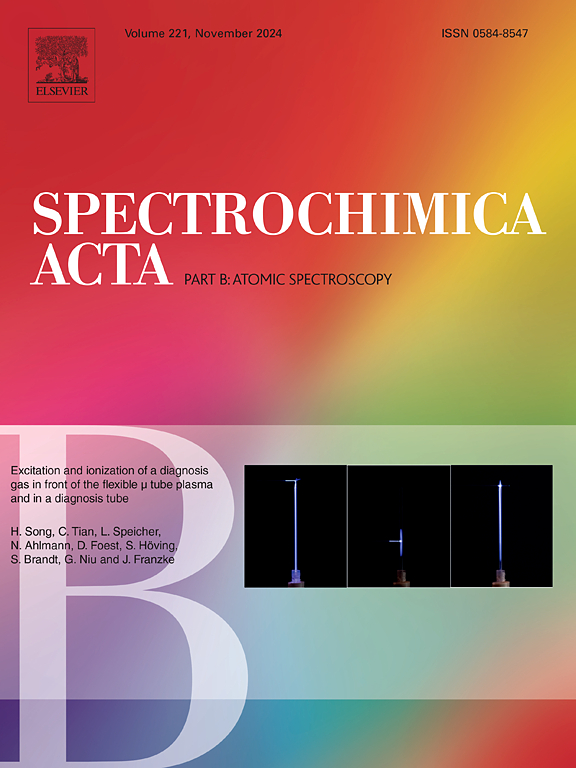Non-linear intensity response in glow discharge emission spectroscopy: Excitation, radiative transfer and self-absorption
IF 3.2
2区 化学
Q1 SPECTROSCOPY
引用次数: 0
Abstract
A comprehensive treatment is presented of signal response in glow discharge emission spectroscopy as function of the analyte concentration and the sputter rate of the sample matrix. Deviations from linear response are expressed by 1/Γ factors. Atomization, excitation, radiative transfer and self-absorption in the Grimm-type discharge is discussed. Experimental data on non-linear intensity response, line profiles of selected lines and some matrix effects are presented in the spectra of copper and zinc in the analysis of CuZnAl alloys and in the spectra of Fe, Ni, Cr. Plausible explanations of the findings are offered, based on the fundamentals of the discharge. Besides self-absorption, non-linear intensity response can also be caused by selective excitation processes due to heavy particle collisions, and even an apparent enhancement of some lines with a rising analyte concentration, a trend opposite to that caused by self-absorption. Charge transfer from argon ions to the atoms of some analyte elements is involved and other heavy particle reactions affecting the spectra, that may be occurring on the cathode surface or in its close vicinity. Similarities and differences with other analytical plasmas are discussed, including laser-induced breakdown spectroscopy.
求助全文
约1分钟内获得全文
求助全文
来源期刊
CiteScore
6.10
自引率
12.10%
发文量
173
审稿时长
81 days
期刊介绍:
Spectrochimica Acta Part B: Atomic Spectroscopy, is intended for the rapid publication of both original work and reviews in the following fields:
Atomic Emission (AES), Atomic Absorption (AAS) and Atomic Fluorescence (AFS) spectroscopy;
Mass Spectrometry (MS) for inorganic analysis covering Spark Source (SS-MS), Inductively Coupled Plasma (ICP-MS), Glow Discharge (GD-MS), and Secondary Ion Mass Spectrometry (SIMS).
Laser induced atomic spectroscopy for inorganic analysis, including non-linear optical laser spectroscopy, covering Laser Enhanced Ionization (LEI), Laser Induced Fluorescence (LIF), Resonance Ionization Spectroscopy (RIS) and Resonance Ionization Mass Spectrometry (RIMS); Laser Induced Breakdown Spectroscopy (LIBS); Cavity Ringdown Spectroscopy (CRDS), Laser Ablation Inductively Coupled Plasma Atomic Emission Spectroscopy (LA-ICP-AES) and Laser Ablation Inductively Coupled Plasma Mass Spectrometry (LA-ICP-MS).
X-ray spectrometry, X-ray Optics and Microanalysis, including X-ray fluorescence spectrometry (XRF) and related techniques, in particular Total-reflection X-ray Fluorescence Spectrometry (TXRF), and Synchrotron Radiation-excited Total reflection XRF (SR-TXRF).
Manuscripts dealing with (i) fundamentals, (ii) methodology development, (iii)instrumentation, and (iv) applications, can be submitted for publication.

 求助内容:
求助内容: 应助结果提醒方式:
应助结果提醒方式:


